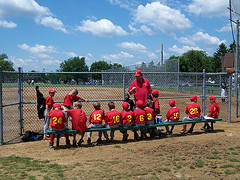Building a Positive Team Culture: Encouragement and Praise
Talk to any coach and they will highlight recite the state that to be a truly great team you need to have a Positive Team Culture. A team’s culture will determine a number of characteristics about the performance that is able to be demonstrated on the court. Teams that have a poor culture easily break, blame, point the finger, fight with each other and ultimately rupture from within. The reality of this is that with the pressure involved in many sporting situations during games and within training sessions if your team is on the negative culture cliff, they could fall at any time. But develop a truly positive team culture and the insignificant and significant issues alike can melt away like the winters first snows. Everything becomes a little easier, players are more resilient and their spirits become galvanized.

When you speak with coaches and ask what they can do to help provide constructive criticisms to players while not destroying the player’s ambition the most widely heard response is the use of the sandwich technique. The sandwich technique is a formula for delivering constructive feedback in a way that places importance on the need for improvement, but does not tear away at the confidence of a player.
The sandwich technique asks that the message is delivered in the following way:
- The first point/comment should be a positive
- The second comment focuses on the specific area needing improvement
- The final comment /point is again positive
At the heart of this type of statement is the encouragement to achieve something more. To stretch that little bit further as an athlete. But because of the method to deliver the message this can also be used as a way of motivating and inspiring, rather than ridiculing and limiting the player.
In a team filled with criticism and judgement players will become limited by their own fear of being chastised and focus on the consequences of their possible failure. In a positive team culture however players can feel like they have more of chance of success and will focus on the reward of their risk taking.
To fulfil this commitment to a positive team culture there are two types of categories feedback should fall into, encouragement and praise. Encouragement should be used as a strategy to provide feedback for when a player attempts an activity or exercise but does not succeed or achieve the desired outcome. An example of this scenario might be when a player attempts a new post move but isn’t successful in the technical execution. In this scenario the focus should be on the attempt to perform the skill, not the ultimate failure to score. At the core of this encouraging feedback will be focus on the technical analysis of how to perform the skill better next time and become that little bit better.
Praise is used when a player is successful in performing the activity. An example of this feedback in action is when a player attempts and is successful in executing a low post move. The coach should focus on the quality and performance of the skill, but again shy away from the outcome of the technique (scoring).
Speaking with your players in this way and encouraging your team to talk amongst themselves with these standards in mind will in the end develop the much wanted positive team culture. When every player on your team understands and physically delivers messages in this way you will know you have succeeded in achieving this outcome and having been a catalyst of something that is very rare indeed.



Very informative article post.Really thank you! Will read on…